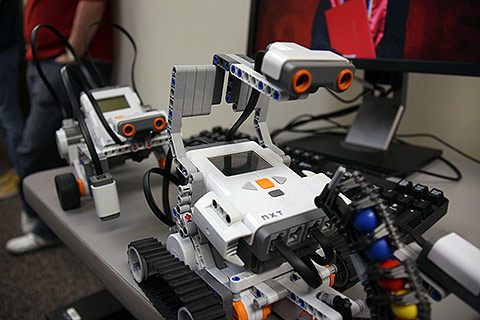Facilities
Robotics Lab

IU Southeast Autonomous Robotics Laboratory develops novel control algorithms for autonomous mobile robots. Our primary focus is swarm-robotics navigation for real world applications.
Engineering swarm robotics systems is difficult due to numerous constraints, such as noise, limited range of interaction with other robots, delayed feedback, and the distributed autonomy of the robots. One potential solution is to automate the design of multi-robot systems in simulation, using evolutionary algorithms(EA). In this paradigm, the EA evolves the behaviors of the robots (and their local interactions), such that the global task behavior emerges. A global observer monitors the collective and provides a measure of performance to the individual robots. Robot behaviors that lead to desirable global behavior are hence rewarded, and the collective system is gradually evolved to provide optimal global performance.
There are several difficulties with above approach. First, a global observer may not exist. Second, some (but not all) robots may experience some form of reward for achieving task behavior, while others do not. Third, this reward may be delayed, or may be noisy. Fourth, the above paradigm works well in simulation (offline) but is not feasible for real-world online applications where unexpected events occur. Finally, the above paradigm may have difficulty evolving different individual behaviors for different robots (heterogeneity vs homogeneity).
Since our interests lie at the intersection of complex adaptive systems such as evolutionary algorithms and swarm robotic approaches, our work has concentrated on developing fast algorithms for multi-robot systems where a large number of robots interact in unknown environments to accomplish a desired goal without global controllers.
Current Members:
- Dr. Suranga Hettiarachchi
- Nolan Pruett
- Stephanie Craig
- Adam Striegel
- Leo Wu
- Ryan Webb
- Brian Forbis
- Ryan Compton
- Erica Wright
- Shawn Pixley
- James Warth
- Harry Lane
- Cory Hurst
Alumnus:
- Andrei Escartin
- Jeramey Tyler
- Jesse Riddle
- Brian Wimpsett
- Alan Lafoon
- Matthew Rayner
- Austin Hall
- Sage Kleczynski
- Erik George
- Michael Francis
- Nicholas Phillips
- Colton Jenkins
- Ryan Hughes
- Nathaniel Biefeld
Research Projects (Current and Completed):
Predictability of Swarm Distribution in Partially Observable Environments: The project analyzes and predicts the required degree of distribution of a swarm in partially observable environments for effective navigation.
Improving Digit Recognition: Design and implement adaptive solutions based on evolutionary and neural network approaches for digit recognition problem. Use neuro-evolutionary optimization to recognize hand written digits.
Object Classification: Distinguishing and Characterizing Objects in An Environment Through Sensor Modalities Using Bayesian Methods. The goal of the project is to provide an autonomously navigating robot the ability to identify various objects with a high probability of correctness, and if that is not possible, then to be able to approximate a best guess as to what that object could be (along with the corresponding probability of correctness)
Game Playing: Using AP-Lite to Implement Pac-Man Game. The goal of the game is simple: collect all the pellets without getting hit by the ghosts. The ghosts try to chase you down, which makes it a race to see who can finish their goal first. This makes an interesting project to implement in real life with robots because it involves multi-robot systems, goal seeking, odometry, and obstacle avoidance.
Neural-Network based minesweepers: Use neuro-evolutionary approaches to produce an optimized solution to minesweeper problem. The minesweepers move on a 2D grid environment looking for mines. The NN in each of the minesweeper takes in the current direction the minesweeper is heading and outputs the optimal force required to turn towards a mine.
Exploration of Disaster Sites Using Autonomous Robots: Goal of the project is to efficiently survey an assigned area for any trace of human life while avoiding obstacles. The robot accomplishes the search task using a combination of pyroelectric human sensors and ultrasonic range sensors. The robot navigation is accomplished using heuristic based algorithms and Physicomimetics.
A user friendly software framework for mobile robot control: Design and develop a Java based software architecture for robotic algorithm implementation.
Publications and Presentations:
A complete list of publications and presentations can be found at Dr. Suranga Hettiarachchi's Homepage




